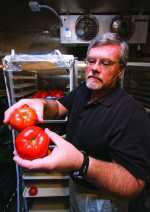Postharvest Tips To Reduce Loss

Keeping perishable horticultural commodities at the right temperature throughout the cold chain is no small task. At the postharvest level, growers must take care to ensure the vegetables being harvested are handled properly, kept free of bruises, and stored and shipped at the right temperatures.
American Vegetable Grower asked Steve Sargent, professor and Extension postharvest specialist at the University of Florida, Horticultural Sciences Department /Institute of Food and Agricultural Sciences, to talk about some of the postharvest issues growers are dealing with, the latest technology, and handling tips.
Q1:Â What course of action do you think is best for growers to take in terms of postharvest food safety issues?
Sargent: It depends on the size of the operation. Small growers must develop and implement adequate Sanitation Standard Operating Procedures (SSOPs) like larger operations, only with the challenge of having fewer resources. However, a number of good publications and training programs are available through
state cooperative Extension services
and from the private sector to assist in this process.
Q2:Â What are some of the latest treatments, in terms of harvest and cooling, that are having a positive impact on postharvest quality and food safety in vegetables?
Sargent: The availability of traceback systems and software can allow shippers to track time/temperature data more effectively. This will assist in determining where breaks or delays in the cold chain may occur. Also, several research groups are revisiting the potential for using harvest-assisted systems on a number of crops to make harvest more efficient and gentler on the vegetables.
Q3:Â What are some tips on the best ways for vegetable growers to reduce losses during harvest, handling, storage, etc.?
Sargent: Growers should routinely step back and look over their harvest and handling procedures to identify points where the crop might be handled roughly or left too long at ambient temperatures. Significant extension in shelf life can be realized by appropriate application of rapid cooling techniques.
We find that changes introduced to current handling practices can have detrimental consequences if not properly evaluated and tweaked as necessary. For example, before switching clamshell container styles for berries, shippers should confirm that cooling rates would not be negatively affected due to lack of sufficient vent holes in the clamshell or improper alignment of the clamshells with the carton vent holes.
For additional information from the Universityof Florida on postharvest issues, go to http://edis.ifas.ufl.edu/topic_postharvest.









